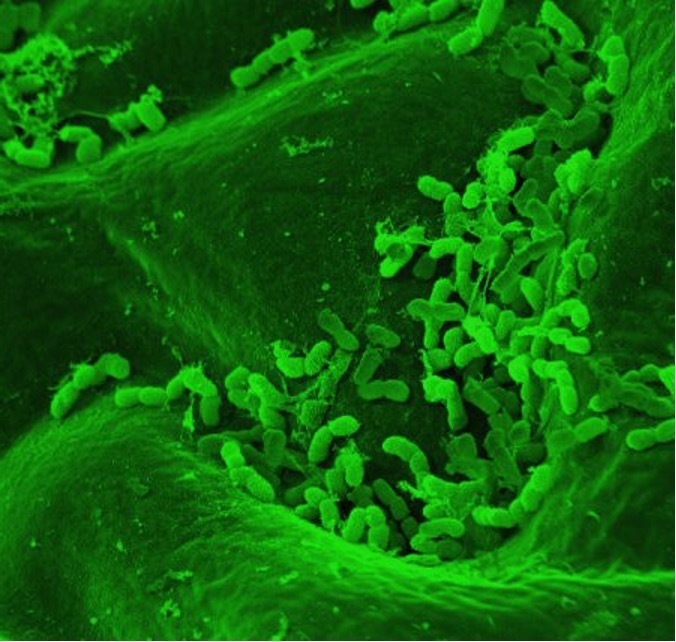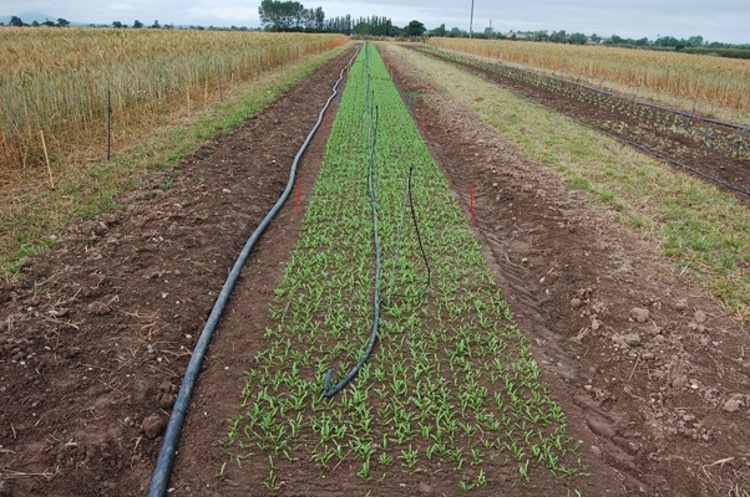In Summary
- If introduced onto the surface of fresh produce, pathogen survival is influenced by various factors, notably being in a biofilm (which is a layer of proteins and other bacteria). Biofilms can protect pathogens and reduce the rate at which they are killed.
- Biofilms are common everywhere that isn’t sterile, for instance, they form on range of newly sprouted seeds within 2 days of germination.
- This said, microbes tend to perish quite quickly on fresh produce, especially when exposed to UV from direct, bright sunlight. Experiments suggest that humidity changes can also influence bacterial survival.
- It is important to note that bacteria are living entities, reproduce quickly, and can adapt to certain conditions, including the surface of plants.
- Experiments have found that typically, when pathogens are intentionally contaminated onto fresh produce, they remain detectable for about a month.
Pathogen decline on phylloplanes
Heaton and Jones (2007) have reviewed contamination of ready to eat produce and survival of microorganisms capable of causing human illness on the phylloplane (the plant leaf and stem surfaces). The basis of the review is that if a pathogen can adapt to survive on the phylloplane, then the chances of an infectious dose of microorganisms remaining at consumption is increased. Early studies by Beuchat (1999) showed that E. coli O157:H7 contained within bovine faeces and introduced onto lettuce could be isolated from lettuce for up to 15 days after its introduction. Later work by Fett (2000) further suggested that basis of survival for human foodborne pathogenic bacteria transferred to the plant surface, is incorporation into phylloplane biofilms (biofilms are microscopic patches of slime which contain bacteria and adhere to a solid surface; the slime protects the bacteria contained within it and makes them difficult to kill; Figure 1). Later still, Morris and Monier (2003) estimated that between 30% and 80% of the total bacterial population on a leaf surface will be contained within a biofilm structure. Furthermore, biofilms tend to be associated with sources of plant nutrients such as leaf veins. Fett (2000) showed that bacterial biofilms were already established on the cotyledons, hypocotyls and roots of alfalfa, broccoli, sunflower and clover sprouts as early as two days after seed germination.

Although there are established strategies which microorganisms can adopt to prolong their survival on phylloplanes, it is, in general, a difficult place for bacteria to survive and most that find their way onto a plant surface will perish quite rapidly (Hutchison et al., 2008). The single most important factor in controlling bacterial numbers on the phylloplane is the ultra violet (UV) radiation contained within sunlight (Jacobs and Sundin 2001; Heaton and Jones 2008). Phylloplane bacterial isolates either tend to have efficient DNA damage repair mechanisms, or preferentially colonise sites that are protected from UV such as within the interior of a leaf or structures shaded from direct sunlight (Jacobs and Sundin 2001). Some potential human pathogens such as shiga-toxin producing E. coli (STEC) have been observed to colonise and persist in the rhizosphere (plant root area) in higher numbers than the phylloplane (plant leaf surfaces), supporting the view that UV irridation reduces bacterial numbers or reduces the liklihood of phylloplane colonisation. (Crozier et al., 2016). Elasri and Miller 1999 report that containment within a biofilm helps protect bacteria against the damaging effects of UV irradiation. It is important to stress that bacteria are not static entities. Phylloplane microorganisms evolve and adapt, becoming more suited to their environment. Bacteria can reproduce quickly and under optimal conditions a new generation can be created as quickly as every 10 minutes. Thus, bacterial adaptation to be better suited to the phylloplane can occur within days rather than years, and phylloplane communities exhibit a marked shift towards UV tolerance as the growing season progresses (Jacobs and Sundin 2001). Of great concern, are the findings of Brandl (2006) who suggests that a period of residence in the phyllosphere may lead to increased virulence of foodborne pathogens as a consequence of the adaptations which must occur in order for them to survive there.

Hutchison et al. (2008) have investigated how long zoonotic pathogens (pathogens that have jumped from animals to infect people) can survive on the phylloplane of crops (Figure 2). Their experiments involved artificially contaminating irrigation water with E. coli O157, Salmonella Typhimurium, Campylobacter jejuni and Listeria monocytogenes before using the water for the irrigation of newly-planted spinach and iceberg lettuce. The numbers of each pathogen were followed on a weekly basis by taking samples of each crop. The experiments were continued until either the numbers were too low to be detected or the plants reached a size suitable for harvest. Two levels of contamination were used: a high contamination treatment and a lower one. As might be expected, declines in bacterial numbers on the phylloplane was observed with time and the treatment with higher numbers of zoonotic pathogens showed longer persistence. In each of the three replicates spanning two growing seasons, the workers observed initial rapid decreases in bacterial numbers. Typically, after one month, the researchers were unable to detect any pathogens on the phylloplane. The experiments were undertaken over a range of day lengths and light intensities. As has been reported previously, intense, bright sunlight caused extremely rapid declines in pathogen numbers (Jacobs and Sundin, 2001).
There is an increasing body of evidence that weather conditions are important for bacterial decline on plant surfaces and that the relationships occurring are complex and controlled by many inter-related factors. Truchado et al. (2019) looked at the interaction of weather conditions, leaf age of baby spinach and irrigation water quality, on the decline of bacterial populations. Cultivation was carried out under commercial conditions with baby spinach irrigated with untreated surface water or irrigated with chlorine dioxide (ClO2) treated water. The results were not entirely conclusive, although some evidence indicated that wind speed, solar radiation and relative humidity had some influence on decline bacterial rates of total mesophiles.
Enterobacteriaceae and Pseudomonas on spinach phylloplanes during field cultivation
The use of disinfected water had no significant effect on the populations of total mesophiles although significant reductions were detected in the Enterobacteriaceae and Pseudomonas. Leaf age did not influence the decline of the bacteria on baby spinach phylloplanes. No interactions between the investigated factors were found. The impact of weather on the die-off rate of Escherichia coli and Salmonella on spinach and lettuce under field conditions was also recently investigated by Belias et al. (2020). The focus of the work was to assess whether the timings between irrigation and harvest in the US Food Safety Moderisation Act (FSMA) were appropriate. Field trials with identical preparations were conducted in California, New York, and Spain over two growing seasons. Baby spinach and lettuce were grown and inoculated with a 4 log cfu/ml cocktail of E. coli and Salmonella that were unable to cause illness. Bacterial decline was monitored and any relationship between weather and bacterial death investigated using statistical analyses. Relationships were identified between climactic conditions and the die off, which was observed to occur either as a linear decline or as two distinct phases. Change in humidity was the key factor associated with whether decline was linear or in two phases. A rapid initial decline and an earlier switch into the secondary slower decline stage was observed for low humidities. The authors concluded that the single timing approach of 0.5 log decline/day used by the FSMA to estimate safe interval to harvest after irrigation may require revision to take better account of the influence of weather conditions on bacterial decline.
References
(click a reference to read it (where it's available); some require purchase from the publisher)